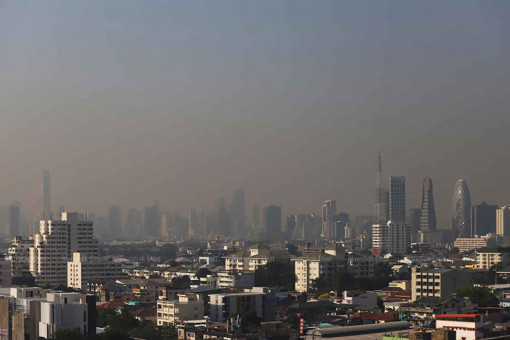PUBLISHED : 15 Feb 2024 at 04:43

Levels of fine particulate matter smaller than 2.5 microns (PM2.5) soared in most Bangkok districts on Wednesday, prompting the Bangkok Metropolitan Administration (BMA) to call on state agencies and private organisations to allow their staff to work from home Thursday and Friday.
In an announcement signed by Bangkok governor Chadchart Sittipunt, the BMA encouraged 151 public and private organisations with 60,279 staff to work from home over those days. However, according to the announcement, schools under the BMA’s jurisdiction will remain open as they have prepared safe zones where students and staff can avoid unnecessary PM2.5 exposure.
AirBKK, the BMA’s air quality information centre, reported as of 11am on Wednesday that 20 districts recorded PM2.5 levels of more than 75 microgrammes per cubic metre (µg/m³), which is considered an alarming level in terms of its impact on health. The safe threshold is 37.5 µg/m³.
Those districts are Klong Sam Wa, Thawi Watthana, Thon Buri, Bangkok Noi, Bang Khen, Bang Bon, Bang Phlat, Bung Kum, Prawet, Lat Krabang, Nong Khaem, Nong Chok, Kannayao, Taling Chan, Bang Na, Pathumwan, Pomprap Sattruphai, Min Buri, Yannawa and Laksi.
As the PM2.5 pollution continues to intensify, people living in the city are advised to stay informed about air pollution levels via AirBKK’s Line Alert.
The Pollution Control Department (PCD) on Wednesday forecast that the PM2.5 pollution situation in Bangkok and the surrounding provinces would intensify until Saturday, while the Meteorological Department said air stagnation, a key factor exacerbating PM2.5 pollution, began on Wednesday and will continue today.
Meanwhile, as many as 3,241 fire hot spots were detected between last Saturday and Tuesday in the Central and Northeast regions and 14,939 in neighbouring Cambodia, said the PCD.
An air quality update supplied by a team from multiple organisations, including the Geo-Informatics and Space Technology Development Agency (Gistda), showed 39 Thai provinces on Wednesday were in PM2.5 pollution red zones, while Bangkok saw 40 districts out of 50 record extremely high PM2.5 levels thus posing a health threat to residents.

